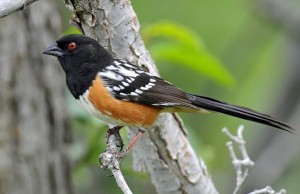 (http://windsor.towns.pressdemocrat.com/2012/04/news/fast-class-windsors-birds/attachment/spottedtowhee/)
(http://windsor.towns.pressdemocrat.com/2012/04/news/fast-class-windsors-birds/attachment/spottedtowhee/)
Order: Passeriformes
Family: Emberizidae
Genus: Pipilo
Species: Pipilo maculatus
Introduction: The Spotted Towhee is a widespread commonly known dimorphic passerine, which can be seen scratching and feeding on the ground under feeders and shrubby areas. Formally known as the Rufus-Sided Towhee (Pipilo erythrophthalmus), with several subspecies, the Towhee was later divided into two species differentiated by their range, plumage and vocalization. Spotted Towhee (Pipilo maculatus) lives in western North America and the Eastern Towhee (Pipilo erythrophthalmus) living in eastern North America and lacks the white spots found on the coverts of the Spotted Towhee. Although some hybridization occurs where the two ranges meet each species will usually pair with another of the same species (American Ornithologists’ Union 1995). The Spotted Towhee’s plumage characteristics include chestnut flanks, a clear white breast and belly, a black head, bill, back, wings, and rectrices, red eyes, and white spotted primary coverts. Females in contrast have a dark grey-brown head, back, wings and rectrices. The juvenal Spotted Towhee’s characteristics include a brown iris, lighter primary coverts, slightly different shaped rectrices, and a smaller white spot on their fourth rectrix than on the adult. (Davis 1957). Towhees are about 8.5″ in length, 10.5″ width and weigh about 1.4oz (Sibley 2001).
The Spotted Towhee can be found in North America throughout most of Canada and the United States, and into northern Mexico. Some populations are migratory which include Idaho, Montana, Wyoming and the Eastern portion of the Dakotas. Come wintertime these birds will migrate to the states in blue located to the south, from Kansas on down into parts of Mexico (Greenlaw 1996).
The Spotted Towhee inhabits dense shrubby areas with broad leaf cover and an essential thick leaf litter and humus . All these factors provide a sheltered, slightly shaded place to search for food with an easily accessible cover of branches and foliage above. (Greenlaw 1996). Towhees have been found to thrive in brushy areas adjacent to an edge created in light urbanization and to utilize feeders and introduced food sources (Lepczyk 2002). However, the Towhee’s survival rate is possibly dependent on the quality of these sites (Gardali and Nur 2006). A negative aspect of residential edges as a habitat would be the influx/density of predators such as raccoons, domestic cats and several species of hawk (Whitaker and Marzluff, 2009).
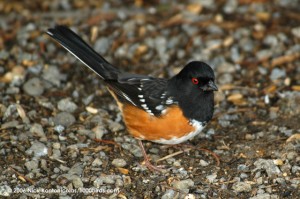 Nick Kontonicolas/1000birds.com 2006 (http://www.1000birds.com/reports_WA_Spotted-Towhee.htm)
Nick Kontonicolas/1000birds.com 2006 (http://www.1000birds.com/reports_WA_Spotted-Towhee.htm)
The Spotted Towhees’ diet varies depending on the biological season. (McClure 2013) During non-breeding season the Spotted Towhee mainly depend on seeds, acorns and fleshy fruits for fuel. When handling these options the Towhee will often pluck or collect the food then retreat to pull and break it apart to eat the desired parts. During the breeding season they will consume and feed to their young, insects (mostly beetles, true bugs, hymenopterans, crickets, grasshoppers, caterpillars and moths) and arthropods (millipedes, sow bugs, spiders) (Greenlaw 1996). Primarily a ground feeder, the Spotted Towhee uses a two footed scratching motion, in which both feet are kicked back simultaneously to unearth their food from under leaves and debris (Greenlaw 1996). This hopping sequence involves two hops. One forward then one back during which its scratches the ground swinging its feet forward and back like a pendulum. Rarely, if this method is unsuccessful the bird will pick up a leaf with its bill to access its prey (Greenlaw 1996). The Spotted Towhee will also eat the fecal sac of its newly hatched young purely as a dietary supplement (McKay 2009)
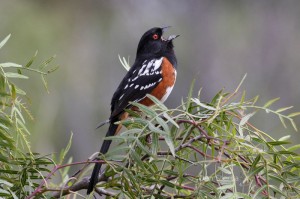 Don Sterba from Culver City, CA (http://www.naturepicoftheday.com/archive/2010-07-16)
Don Sterba from Culver City, CA (http://www.naturepicoftheday.com/archive/2010-07-16)
The Spotted Towhee has a loud, geographically varied call and song that can be heard by human ear from up to 750 feet away (Davis 1958). The Towhee uses its call to communicate with its mate and announce disturbances and alarm in its territory. It is one of the first forest birds to call alarm and then falls silent and waits longer than most to call again when the danger has passed (Young 1999). The Towhee’s vocalization has been described as a drawn-out buzzy trill, “chweeeee”,”tu-wheeze”, or a long drawn out “breee”(Davis 1958). The western Spotted Towhee differs from the Eastern Towhee’s call in the introduction. The Spotted Towhee will often only have one introductory note or none at all (Borror 1975). In a recent study Spotted Towhees exposed to high levels of noise pollution reportedly altered their vocalization volume above that of local noise pollution and became less responsive to territorial intruder calls (Kleist 2012).
Call: Recorded by Rajani Dalgleish 10/29/2014 1:53 PM by the Long House (Olympia, WA).
Song (Male)- Recordist: Eric DeFonso 05/23/2014 San Miguel County, CO.Obtained from xeno- canto
Call (Male)- Recordist: Ian Cruickshank 06/18/2014 Petworth Dr, Highlands, Vancouver Island, BC. Obtained from xeno- canto
Call. Provided by xeno-canto, XC473453. Recorded by Bow Tyler on 5/5/2019 at Mission Creek Nature Park, Olympia, WA.
Song. Provided by xeno-canto, XC473452. Recorded by Bow Tyler on 5/5/2019 at Mission Creek Nature Park, Olympia, WA.
Additional Song. Provided by xeno-canto, XC473437. Recorded by Bow Tyler on 5/1/2019 at Woodard Bay Conservation Area, Olympia, WA.
The Spotted Towhee experiences periodic changes in weight, bill length, intestinal length and gonads, which correlate with the winter and breeding seasons. In the winter, the Towhee’s diet changes to consist of more seeds and more abrasive content such as dirt and grit is found in the intestine. This abrasive content could be the causation of the shortened winter bill length as the abrasive material files down the bill as well as intestinal lengthening to accommodate the rough content (Davis 1961). Gonadal changes in male begin in February beginning the breeding season. Testis regression begins mid July following the end of all mating and breeding responsibilities in June (Davis, 1961). Recent studies on microbial communities in the cloaca of female Spotted Towhees found a correlation between richness of microbial communities and shorter tails and narrower bill width and weight in females. Positive and negative bacterial exposure occurs during copulation as well as to from parent to young immediately following hatching. The richness of the communities seems to be influenced by human activity raising the question of how human activity is affecting the overall health of the species (Klomp 2008).
Pacific Northwest populations along and near the coast do not migrate but some populations farther inland are partly migratory traveling to more southern regions of their range. Towhee’s have rounded wings that are great for maneuvering but do not make for great long distance flying. (Greenlaw 1996). With the exception of the occasional retreat to a nearby tree to evade threat, the towhee prefers to stay close to the ground and generally will stay in the safety cover of brush (Cohen 1899). They do not require the safety of a flock but will forage with a flock of sparrows if they come into the Towhees foraging area. (Greenlaw 1996)
Nesting, breeding and predation:
Towhees form seasonal monogamous pair bonds beginning in February. During which the pair stays very close together at all times (Greenlaw 1996). Nests are commonly built into the litter on the ground or elevated in vegetation. (Cohen 1899 and Davis 1960) Copulation occurs either on the ground or a low perch and last only a few seconds then the male flies away (Greenlaw 1996). Towhees are frequently flicking their tail. Females will almost always stop and perch near their nest and flick their tail several times before descending to their eggs or young (Davis 1957). Depending on the quality of the Towhee’s diet, a Towhee’s clutch size can vary from 2-5 eggs averaging around 3 Individuals with a rich diet will lay more eggs than those with a poorer diet (Greenlaw 1978). Nest failure is normally due to predation from birds, mammals, snakes and ants (Small 2005). The Towhee’s nest is occasionally targeted by the parasitic Brown-headed Cowbird (Molothus ater) in which case one of the eggs maybe tossed from the nest and replaced by that of the Brown-headed Cowbird (Greenlaw 1978). Although parasitism can lessen the clutch size in a Spotted Towhee’s nest that has been preyed on by the Brown-headed Cowbird, it has been suggested that the nest actually experiences a lower level of predation compared to other species; causing the nest to be more successful than nests unaffected by the Brown Headed Cowbird. This could be due to the Cowbird’s aid in protecting the nest although not enough supporting evidence exists to be certain (Small 2007). The clutch is incubated by the female for 12-14 days. The young birds stay with the parents for about a month after leaving the nest (Greenlaw 1996).
Population Trends:
According to the North American Breeding Bird Survey Trend Results (1966-2011 and 2001-2011 trends) the overall population trend of the Spotted Towhee is stable, neither increasing nor decreasing.
In some areas the population trend is increasing or stable as demonstrated in the Great Basin, Central Mixed Grass Prairie’s of the U.S. and Canada, Nebraska, and surprisingly Washington However in Oregon, Colorado, New Mexico, Arizona, the Chihuahuan Desert, and Sierra Madre Occidental the population trend is decreasing (Sauer 2011). The Chihuahuan Desert grasslands of southwestern USA and northern Mexico are being lost to desertification and shrub encroachment due to agricultural expansion (Punjabi 2010).
Conservation Issues:
Although Spotted Towhee’s are listed under the category, “Least Concern” by the North American Breeding Bird survey; humans still have a complicated impact on the species lives. The way we manage our landscapes, especially natural habitats, can have adverse affects on this species. As previously mentioned this bird thrives in dense brush and a thick undergrowth (Greenlaw 1996). If this type of habitat is not protected or given consideration in land management practices, the Spotted Towhee could continue to decline within certain populations. All is not lost for Island Towhees as Van Buren (2013) found on Santa Cruz Island where they have made a big comeback in the 24 years with a feral sheep-free environment. These thin corridors of habitat that can sustain a population of Towhees can be over-grazed by cattle leaving them nowhere to go (Greenlaw 1996).
Human-disturbance levels such as urbanization and high-density residential communities lead to a decrease of Spotted Towhee populations.A recent study has shown that as the landscape gets closer to the urban area, there is a decrease in occupancy in that landscape by the species. (Melles et al 2014) This can come from several factors which could possibly include noise pollution, although results have been inconclusive. (Francis et al. 2012) Predation is another big factor. While Spotted Towhees can produce more offspring at the edge of a residential area, predation from domestic cats and Western Screech Owls gives fledglings less of a chance for survival. (Shipley et al. 2013) Only 36 of 52 fledglings survived during their analysis of “residential edges along a forested urban park” (Shipley et al. 2013). The results were similar in a study carried out by Whitaker and Marzluff (2009) where juvenile survival rate decreased in high urbanization and increased within forested sites. The Spotted Towhee is a useful indicator and is commonly used to measure an ecological restoration site’s success. One example of this process is a study taken in the California Sacramento River area where it was found to colonize the restoration area within a few years of planting (Small 2007).
90% of what I observed from the Spotted Towhee’s was foraging behaviors. The majority of the time they were on the ground and always moving. They hop around on the ground and displaying their common technique, the two-footed hop in which they hop and simultaneously scratch at the ground to undercover food from under the dirt. The females were a lot more vocalizing and seemed more aggressive than the males. When a disturbance would occur the female was more likely to vocalize and show aggression, whereas the male would flick his body but retreat to a branch overhead and observe the disturbance before anything else. Both males and females are territorial and will flick their bodies at anything that makes them anxious. This includes people, loud noises, other species of birds, and other animals. They will do it more violently depending on the situation such as whether or not the “threat” is close to their nest or not; and what the threat is doing, trying to steal food or attacking them.
Birds of Evergreen draft 4 Observational-Field-Notes-Spotted-Towhee1
All pictures are obtained from Google Images. I do not own any of them. No copyright Infringement Intended.
American Ornithologists’ Union. 1995. Check-list of North American Birds, Fortieth supplement to the American Ornithologists’ Union. Auk 112: 819-830.
Barton, D. C., and Holmes, A. L. 2007. Off
Beal, F.E.L.1910. Birds of California in relation to the fruit industry. Washington Government Printing office. 86-89.
Betts, M. G., Fahrig, L., Hadley, A. S., Halstead, K. E., Bowman, J., Robinson, W. D., … & Lindenmayer, D. B. (2014). A species
BirdWeb. N.p., n.d. Web. Spotted Towhee. 2012.
Borror, D. J. 1975. Songs of the Rufous-sided Towhee. Condor 77: 183-195.
Chang, Y. M., Hatch, K. A., Bogardus, R. M., & Eggett, D. (2013). The Influence of Avian Aerial Predator Location on Perceived Predation Risk and Foraging Location in Five Passerine Species. Journal of Science and Innovation, 3(3), 97-111.
Cohen, D. A. 1899. Nesting and other habits of the Oregon Towhee. Condor 1:61-63.
Davis, J. 1957.
a. Determination of age in the Spotted Towhee. Condor 59: 195-202.
b. Comparative Foraging Behavior of the Spotted and Brown Towhees. The Auk 74:129-166.
Davis, J. 1958. Singing behavior and the gonad cycles of the Rufous-sided towhee. Condor 60: 308-336.
Davis, J. 1961. Some seasonal changes in morphology of the Rufous-sided Towhee. Condor 63: 313-321.
Bolger, D.T., Patten, M.T., and Bostock. D.C. 2005. Avian reproductive failure in response to an extreme climatic event. Oecologia, Vol. 142, No. 3: 398-406
Dybala, K.E., et al. 2014. Does restored riparian habitat create ecological traps for riparian birds through increased Brown-Headed Cowbird nest parasitism?. Ecological Restoration 32.3: 239-248.
Francis, C.N., Kleist, N.J., Davidson, B.J., Ortega, C.P., Cruz, A. 2012. Behavioral responses by two songbirds to natural-gas-well compressor noise. Ornithological Monographs. 74:36-46.
Gardali, T, and Holmes, A. 2011. Maximizing benefits from riparian revegetation efforts: Local- and landscape-level determinants of avian response. Environmental Management : 48 :28-37.
Gardali, T. and Nur, N. 2006. Site-specific survival of Black-headed Grosbeaks and Spotted Towhees at four sites within the Sacramento Valley, California. The Wilson Journal of Ornithology, 118(2): 178-186.
Goguen, C. B., Mathews, N. E. 1998. Songbird community composition and nesting success in grazed and ungrazed pinyon-juniper woodlands. The Journal of Wildlife Management, Vol. 62, No. 2. 474-484
Greenlaw, J. S. 1978. The relation of breeding schedule and clutch size to food supply in the Rufous-sided Towhee. Condor 80: 24-33.
Greenlaw, J. S. 1996. Spotted Towhee (Pipilo maculatus), The birds of north america online (A. Poole, Ed.). Ithaca: Cornell Lab of Ornithology; Retrieved from the Birds of North America Online:
Hennings, L. A., Edge, D.E. 2003. Riparian bird community structure in Portland, Oregon: Habitat, Urbanization, and Spatial Scale Patterns. The Condor, Vol. 105: 288-302.
Klomp, J.E., Murphy, M. T., Smith, S. B., Mckay, J. E., Ferrera, I. and Reysenbach, A. 2008. Cloacal microbial communities of female spotted towhees Pipilo maculatus: microgeographic variation and individual sources of variability.
Lepczyk, C.A., Warren, P.S., 2002. Urban bird ecology and conservation. University of California Press. 167-300.
Linsdale, J. M., and E. L. Sumner Sr. 1937. Weights of spotted towhees. Condor 39: 162-163.
McClure, C. J., Ware, H. E., Carlisle, J., Kaltenecker, G., and Barber, J. R. (2013). An experimental investigation into the effects of traffic noise.
McClure, C. J., Rolek, B. W., & Hill, G. E. (2013). Seasonal use of habitat by shrub-breeding birds in a southeastern national forest. The Wilson Journal of Ornithology, 125(4), 731-743.
McKay J. E., Murphy, M. T., Smith, S. B., and Richardson, J. K., 2009. Fecal-sac ingestion by spotted towhees. The Condor 111(3):503-510.
Melles, S., Glenn S., and Martin K. 2003. Urban bird diversity and landscape complexity: species–environment associations along a multiscale habitat gradient. Ecology and Society. 1-22. Indiana University. The Resilience Alliance. Web. 20 Nov. 2014. <http://dlc.dlib.indiana.edu/dlc/handle/10535/3247>.
Punjabi, Arvind, Youngberg E., and Levandoski, G. 2010. Wintering grassland bird density in Chihuahuan Desert grassland priority conservation areas, 2007-2010. Rocky Mountain Bird Observatory, Brighton, CO, RMBO Technical Report I-MXPLAT-08-03. 83
Porzig, E.L., et al. 2014. Habitat suitability through time: using time series and habitat models to understand changes in bird density. Ecosphere 5.2: art12.
Sauer, J. R., J. E. Hines, J. E. Fallon, K. L. Pardieck, D. J. Ziolkowski, Jr., and W. A. Link. 2011. The north american breeding bird survey, results and analysis 1966 – 2010. Version 12.07.2011
Shipley, A., M. Murphy, A. Elzinga. 2013. Residential edges as ecological traps: Postfledging survival of a ground-nesting passerine in a forested urban park. The Auk, 130(3):501-511.
Sibley, D, Elphick, C., and Dunning, J.B. 2001. The sibley guide to bird life & behavior. New York: Alfred A. Knopf, Print.
Sibley, D. 2003. The sibley field guide to birds of western north america. New York: Knopf, Print.
Small, S. 2005. Mortality factors and predators of Spotted Towhee nests in the Sacramento Valley, California. Journal of Field Ornithology. 76 (3): 252-258.
Small, S. L., Thompson III, F. R., Geupel, G. R. and Faaborg, J. 2007. Spotted Towhee population dynamics in a riparian restoration context. The Condor: 109: 721-733.
Van Buren, D.H., 2013. Avian response to removal of feral sheep on Santa Cruz Island, California. The Wilson Journal of Ornithology. Vol. 125, No. 1 (March 2013) (pp. 134-139).
Whittaker, K.A., J. Marzluff, 2009. Species-specific survival and relative habitat use in an urban landscape during the post-fledgling period. The Auk, 126(2):288-299.
Young, J. 1999. Advanced bird language: reading concentric rings of nature. Eight Shields publishing. disc 1-8.

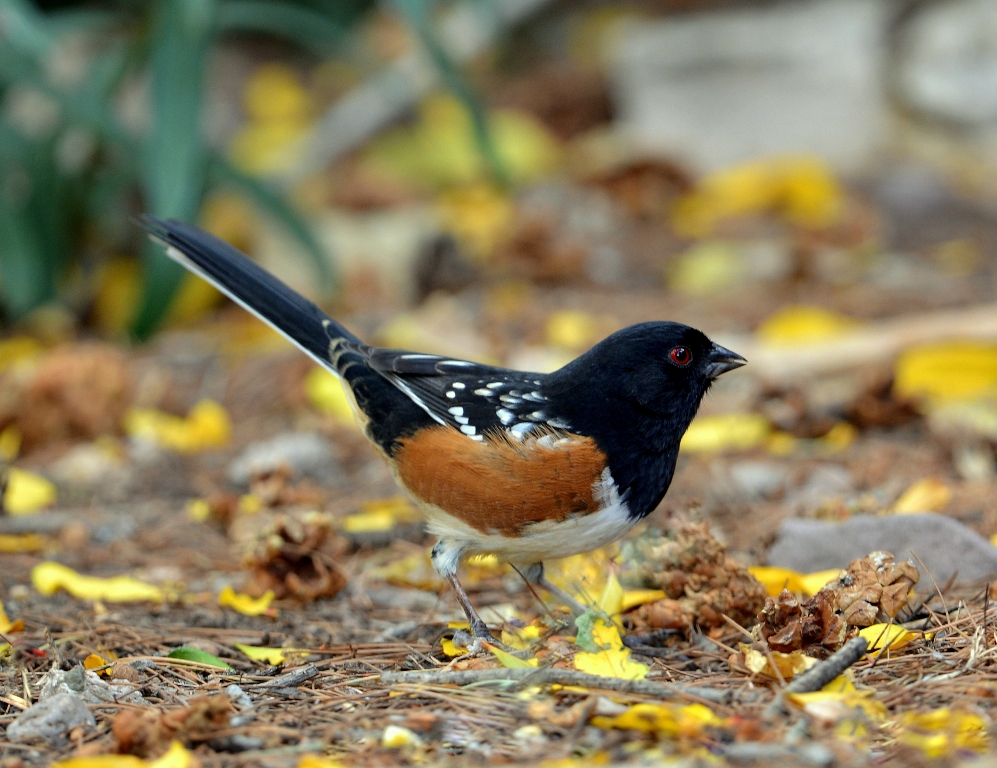
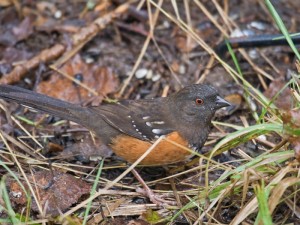
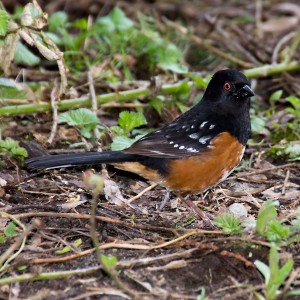
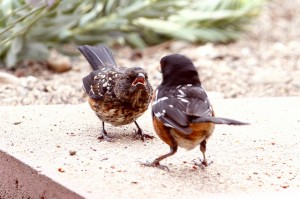
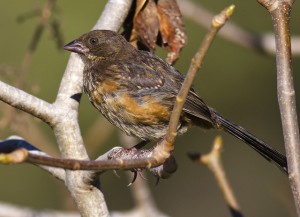
Leave a Reply